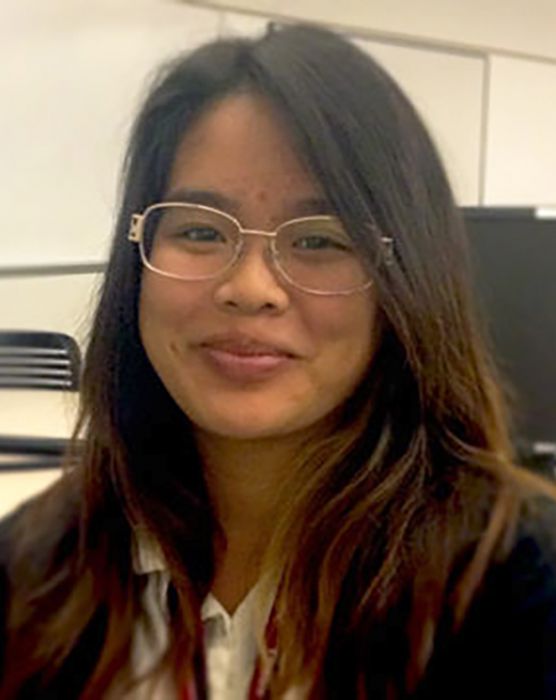Story compliled from the orginial piece written by Donna Cruz, Office of the Provost, Division of Acacemic Affairs. Photographs by Donna Cruz.

When the California State University (CSU) system offered California State University, Dominguez Hills (CSUDH) the opportunity to be the test campus for the Affordable Learning Solutions (ALS) program in 2009, University Library staff ran with it, as did the faculty.
Today, they lead the way for faculty throughout the 23-campus CSU system in providing more affordable, quality educational content for their students through free and low-cost e-books, and other learning materials.
“The aim here at CSUDH was to get as many free textbooks as we could into the hands of students,” said Naomi Moy, director of reference resources in the library and coordinator of the ALS program since its official launch on campus in 2010. She works with Karen Clemons, electronic resources assistant, to research a vast array of free content to assist faculty in the development of ALS materials.
By fall semester 2014, 155 CSUDH professors had participated in ALS, more than any group of educators in the CSU. Moy, who estimates that the number will double in spring 2016, said that there are currently more than 700 articles, e-textbooks and other resources on the University Library webpage that were placed there by faculty.
Rising Costs
For decades, textbook costs have risen substantially each year: from 1986 through 2004 the price of textbooks in the United States rose 186 percent, approximately six percent per year. The annual cost for textbooks and supplies today for full-time students is $1,764, or $500 to $850 for part-time students.
Thuytrang Lieu, a CSUDH healthcare management major, is taking advantage of the cost savings ALS offers, and the technology.
 “Saving money on textbooks benefits me in numerous ways. First, it really saves me a vast amount of money that can go toward my tuition, transportation, and–last but not least–sustenance,” said Lieu. “It is also advantageous for me to be able to access course information through a variety of mediums instead of just using a book. I can access it anywhere and anytime as long as there is Wi-Fi or data usage on my mobile device.”
“Saving money on textbooks benefits me in numerous ways. First, it really saves me a vast amount of money that can go toward my tuition, transportation, and–last but not least–sustenance,” said Lieu. “It is also advantageous for me to be able to access course information through a variety of mediums instead of just using a book. I can access it anywhere and anytime as long as there is Wi-Fi or data usage on my mobile device.”
Richard Propster, a lecturer who teaches human resource management at CSUDH, joined the ALS program in spring 2014. He teaches as many as 35 students per semester who are mostly graduating seniors, and some freshmen. Many of his students are in their late 20s, and some are taking up to seven classes per semester.
“The main text I use is available to students with a liberal ability to print the pages that are of most value to them,” said Propster, who said his students save approximately $200 in books. “We also use an array of timely articles from professional journals, such as Harvard Business Review, by providing links to free copies through our library.”
Open Education Resources
Along with low-cost and free textbooks, ALS also encourages the use of other types of academic materials, such as commercial, library and web resources, particularly those found free on open educational resources (OER) websites.
OER materials are contained in digital media collections posted by institutions around the world that are available to college educators, K-12 teaches, students, and self-learners. They include full courses, syllabi, lectures, homework assignments, quizzes, lab and classroom activities, pedagogical materials, and many more resources.
 The California Open Educational Resources Council, which is made up of CSU, University of California and California Community College faculty, is facilitating the review of textbooks for inclusion in the state’s own OER, called California Open Source Digital Library (COOL4Ed).
The California Open Educational Resources Council, which is made up of CSU, University of California and California Community College faculty, is facilitating the review of textbooks for inclusion in the state’s own OER, called California Open Source Digital Library (COOL4Ed).
The greatest achievement we are experiencing is moving the discussion from classroom to virtual space. -Dean Ramser
Dean Ramser, who teaches English composition at CSUDH and is involved in the COOL4Ed program, said his students would typically pay $90-$130 for textbooks. Among the resources Ramser is evaluating and using is WriteLab, a beta software program that analyzes students’ writing and provides custom feedback to help them improve and revise their writing.
“The greatest achievement we are experiencing is moving the discussion from classroom to virtual space,” said Ramser. “This is important because so much of our information is no longer delivered face-to-face. A lot of what we do is Internet-based.”
 Lilian Quach, a freshman studying Digital Media Arts at CSUDH, is a big advocate of OER, and all the resources the library has to offer.
Lilian Quach, a freshman studying Digital Media Arts at CSUDH, is a big advocate of OER, and all the resources the library has to offer.
“I would recommend students to use these resources regularly because if does help them in other areas as well, such as English,” she said. “If you are trying to talk about a certain subject, you can also look up articles on the databases the library offers. It helps you get to your main point.”
For more information about the Affordable Learning Solutions program and to find contact information visit here.